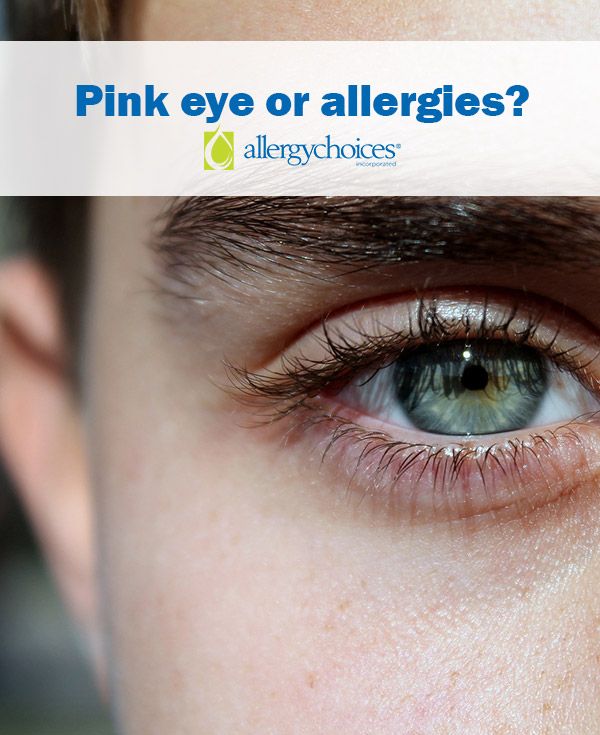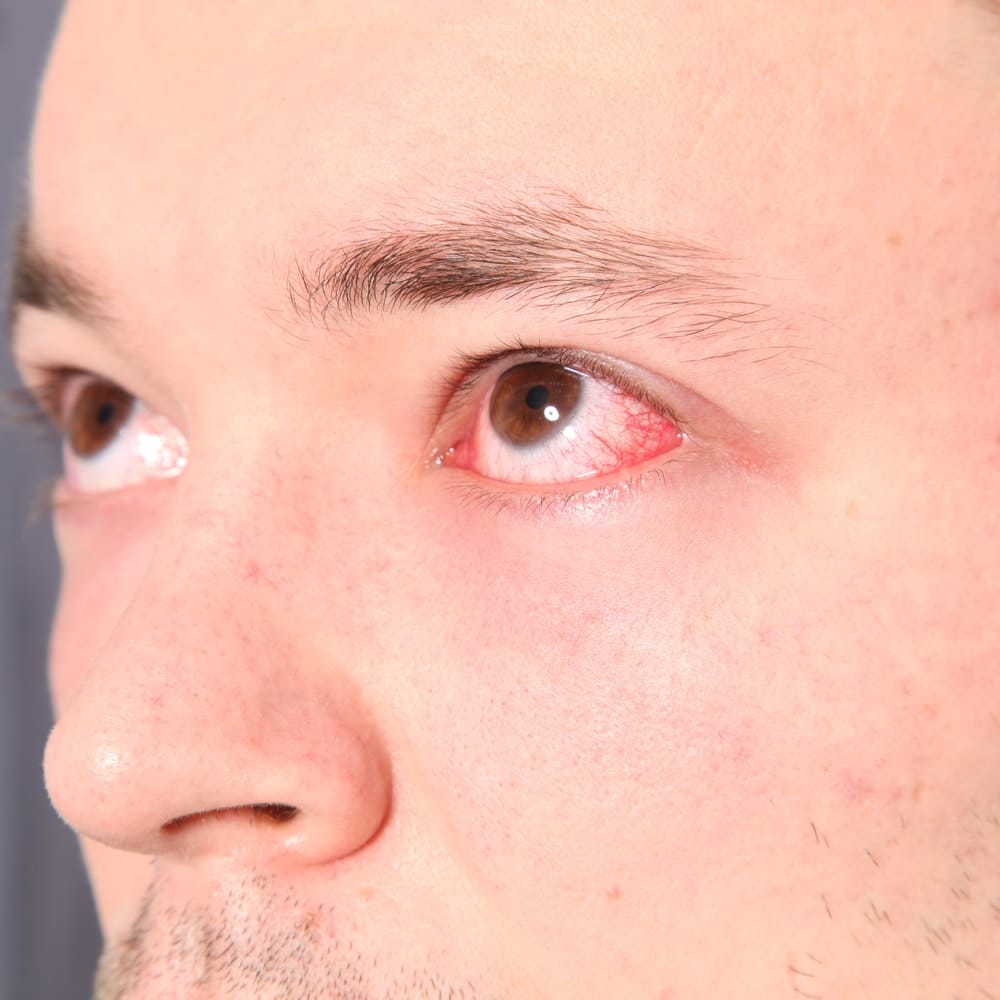What Causes Allergic Conjunctivitis
You experience allergic conjunctivitis when your body tries to defend itself against a perceived threat. It does this in reaction to things that trigger the release of histamine. Your body produces this potent chemical to fight off foreign invaders. Some of the substances that cause this reaction are:
- pollen from trees and grass
- chemical scents such as household detergents or perfume
Some people may also experience allergic conjunctivitis in reaction to certain medications or substances dropped into the eyes, such as contact lens solution or medicated eye drops.
Eye Allergy Treatment And Tips
The best way to treat eye allergies is to mitigate exposure to the allergens causing the issue. This can be especially true if you have seasonal allergies. Try to limit time outdoors when pollen is at its peak, and clean your air filters in the fall and winter to help prevent cold-weather allergies.
Eye Drops For Moderate To Severe Allergies
These are usually decongestant eyes drops, importantly these type of eye drops are not recommended if you have glaucoma.
These eye drops are over-the-counter and are used to reduce redness by narrowing the blood vessels in the eye. They are available in two forms: decongestant only, and decongestant with an antihistamine recommended for relief of severe itching.
Also Check: Can Pollen Allergies Cause Heart Palpitations
What Is The Treatment For Dry Eye
Artificial tears lubricant eye drops are the main treatment for dry eye. They can keep the eye moist and reduce symptoms. You can buy artificial tears at a drug store or grocery store without a prescription. They come in liquid, gel or ointments. Preservative-free artificial tears are best for long-term use, but they are more expensive.
Other things you can do to help improve dry eye include:
- Try to blink a lot, especially when you are reading or using a computer. This helps keep your eyes moist.
- Avoid excess air conditioning or heating as much as you can. Also avoid sitting directly in the flow of cold or hot air.
- Use a humidifier in your bedroom and any other space where you spend a lot of time.
- Use goggles or moisture chambers if your doctor or nurse suggests them. Moisture chambers are special devices that fit on your glasses. They can help keep your eyes moist. You can buy moisture chambers at most stores that sell glasses.
Additional treatments include prescription eye drops and anti-inflammatory medicines. If these are not successful, tear duct plugs or surgery that requires the assistance of an ophthalmologist may be recommended.
Many people with difficult-to-control dry eye struggle with wearing contact lenses and may need to stop using them for as long as symptoms persist.
Causes Of Eye Allergies

You may have an allergic reaction if your eyes come into contact with certain chemicals or airborne allergens. Indoor causes of eye allergies are generally irritants circulating in the air or trapped in common household items and surfaces. These include:
Indirect exposures and risk factors include:
- Having certain food allergies
- Insect bite or sting allergies
You May Like: Can You Eat Butter If You Have A Milk Allergy
When To Contact A Medical Professional
- You have symptoms of allergic conjunctivitis that do not respond to self-care steps and over-the-counter treatment.
- Your vision is affected.
- You develop eye pain that is severe or becoming worse.
- Your eyelids or the skin around your eyes becomes swollen or red.
- You have a headache in addition to your other symptoms.
White Blood Cell Test
This is not a straight-forward blood test, and doctors dont usually prescribe this test for a normal allergic reaction . Your symptoms have to be more severe for this test to make sense.
Doctors will turn to this exam if your eyes are extremely irritated or red or if theyre swollen. The procedure entails extracting and examining certain eye tissues, especially in the eyes conjunctiva.
Results will show your white-blood cell count, a clue that your immune system is working overtime to repel an allergen.
Recommended Reading: Do Allergies Cause Sinus Infections
Treating Eye Allergies And Dry Eye At Dmei
If you are experiencing symptoms of dry eye syndrome or allergic conjunctivitis, contact DMEI to schedule an appointment with one of our doctors to diagnose your condition. A comprehensive eye exam will help us learn more about the cause of your eye irritation and help us develop a personalized treatment plan.
Beyond eye drops, at DMEI, we offer both LipiFlow and intense pulsed light treatment options for people with dry eye. LipiFlow is an FDA-approved treatment for Meibomian gland dysfunction that warms and massages the inside of the eyelids to improve how oil flows from the meibomian glands. IPL uses short bursts of specific wavelengths of light applied to the skin around the eyes to penetrate and stimulate collagen restructuring, prevent meibomian gland atrophy, decrease vascular inflammation, as well as warm the Meibomian glands internally.
View a directory of the primary eye care doctors at our three locations in the Oklahoma City metro area by clicking on the directory link below. To schedule an appointment, call 405.271.6060 or 800.787.9012, or fill out an appointment request form using the button below.
Is It Pink Eye Or Allergies
It can be difficult to tell the difference between allergic conjunctivitis and pink eye, a conjunctivitis caused by a virus or bacteria. Eye allergy tends to clear secretions and itching, while bacterial infections causing pink eye usually involve yellow or greenish discharge. Most conjunctivitis is viral rather bacterial and resolves well after applying warm compresses. If only one eye is affected, take care to not touch or apply anything to the unaffected eye after touching the eye with the issue.
Never put corticosteroid drops into your eyes without having a comprehensive eye exam. It is very difficult to tell the difference between conjunctivitis caused by allergy or conjunctivitis caused by bacteria corticosteroids can be dangerous with certain bacterial diseases. Eye allergy tends to cause clear secretions and itching, while bacterial infections usually involve yellow or greenish secretions.
If you suspect that you have eye allergies visit a healthcare professional. Preventing and treating eye symptoms may be part of your overall treatment plan.
You May Like: Is Coconut A Peanut Allergy
Medication For Allergy Eyes
Artificial tears bring only temporary relief. They will wash out allergens, but if you dont remove the source they will just return.
Oral antihistamines can stop the watering, but they can dry out your eyes.
Prescription antihistamines and corticosteroids can bring relief from allergy eyes as well as respiratory systems. These can be taken orally or as a nasal spray.
While not technically a medication, immunotherapy can be highly effective. It teaches your body to naturally suppress the immune response.
The best medication for allergy eyes is avoiding allergens. If you arent sure what is triggering your allergic reactions see the allergist for testing.
Allergy Medications For Eyes
Over-the-counter and prescription medications can give short-term relief of some eye allergy symptoms. Prescription treatments can provide both short- and long-term help.
Sterile saline rinses and eye lubricants can soothe irritated eyes and help flush out allergens.
eye drops can curb eye redness by constricting blood vessels in the eyes. These drops tend to sting a bit, and they donât relieve all symptoms. Whatâs more, their effect tends to be short-lived. If you use them for more than a few days, it can cause ”rebound” eye redness.
eye drops containing ketotifen can ease allergy symptoms for up to 12 hours. They wonât cause rebound redness even with long-term use.
Refrigerating your eye drops may bring more relief.
In addition to red, itchy eyes from allergies, many people also have other symptoms, like a stuffy, runny nose. If you do, nasal steroid sprays can help your eyes and nose. Over-the-counter options include Flonase, Rhinocort, and Nasacort. Several others are also available with a doctor’s prescription.
Oral antihistamines can also help. Cetirizine and loratadine tend to be less sedating than some older drugs, and they provide longer-lasting relief. Keep in mind, though, that oral antihistamines do dry the eyes and can make a dry eye condition worse.
If you need more help, a doctor can prescribe other eye drops. For severe or persistent cases, immunotherapy can also help.
Show Sources
Recommended Reading: Does My Child Have A Gluten Allergy
What Can You Do For Eye Allergy Treatment And Relief
The best thing to do is to totally avoid whatever eye allergens and irritants bother your eyes. However, this is hard since these triggers are airborne.
Here are some tips to keep your eyes clear, clean and comfortable:
- Use a preservative-free eye wash or artificial tears to moisten dry, irritated eyes and help wash out allergens and irritants.
- Put a damp washcloth in the freezer for a few minutes and then apply it to your eyelids to reduce itching and swelling.
- Keep your hands away from your eyes. Wash your hands and face after being outside on high pollen and mold days.
Treatment Depends On Severity And Cause Of Symptoms

Identifying and removing the cause of allergic conjunctivitis, where possible, is ideal when an allergic cause has been confirmed from allergy testing. For example:
- House dust mite minimisation measures in the bedroom .
- Removing the cat from the house in sensitive individuals.
It is also important to exclude the presence of a foreign body such as dust, wood chip or an insect/s.
Symptoms of allergic conjunctivitis are generally mild to moderate and respond to bathing eyes with cold water, ice packs and cold water compresses. Topical lubricants can also help flush allergens from the tear film. However, symptoms can sometimes be extremely severe and debilitating and require medication. Treatment options include:
Also Check: How Much Do Allergy Shots Cost
Why Do Allergies Cause Puffy Eyes
Allergies are triggered by exposure to certain environmental agents that are harmless to most peoples systems. However, for those with allergies, the immune system reacts defensively by releasing histamines into the bloodstream to fight these allergens. These histamines cause the blood vessels in the eye to become puffy and swollen.
What Can Be Done To Relieve Eye Allergies
There are preventive measures you can take to minimize the risk of suffering from eye allergies. Certain medications can also help relieve the symptoms.
If you want to avoid triggers of your eye allergy, observe the following practices:
1. Wear eyeglasses or sunglasses when outdoors. This will help keep the pollen out of your eyes.
2. Wash your hands after touching pets.
3. Keep your windows closed during pollen season. Use your air conditioning, and make sure your air filter isnt clogged with dirt.
4. Use mite-proof bedding so that you can minimize your exposure to dust mites. Consider running dehumidifier to reduce the risk of mold growth.
There may be days when you have no control over your environment, but dont worry because there are nonprescription medications that you can use to relieve your allergies. These include eye drops and antihistamines.
1. Eye Drops You can choose among several brands of non-prescription eye drops to relieve itchiness, redness, and watery eyes. These eye drops are good for relatively mild symptoms.
2. Antihistamines Your body responses to allergens by releasing histamine, a substance that dilates blood vessels and makes the walls of blood vessels permeable. This then results in a runny nose and itchy, watery eyes. Antihistamines reduce such effects by blocking the attachment of histamine to the cells in your body, which produce an allergic reaction.
Don’t Miss: Why Are Allergies Worse In Spring
How Is A Stye Treated
Never squeeze or try to pop a stye. It can spread the infection to the rest of your eyelid.
Most styes go away on their own in about a week. Oral antibiotics can be used if the stye isnt healing on its own.
A warm compress is the primary home remedy for a stye. You can make one by soaking a washcloth in hot water until its as warm as you can tolerate without burning your skin.
A warm compress can:
- help liquify the hardened material in a stye, allowing it to drain
- draw the pus in an external stye to the surface where it can come to a head before bursting
- unclog the gland, providing a drainage route for the pus and debris especially in internal styes
The American Academy of Ophthalmology recommends using a compress for 10 to 15 minutes, three to four times a day when you have a stye. Using a compress once a day can prevent a new or recurring stye, if youre prone to getting them.
Massaging the stye during or after the warm compress helps break up the material in the stye so it can drain better. Use your clean fingertips, moving in a circular pattern.
There are many eyelid cleansers available, which are designed specifically to help cleanse the eyelids. Gentle shampoo or mild soap on a cotton swab can also be used to remove drainage and crusting.
A small amount of blood may be present in the drainage, which is normal. If theres a lot of blood, see a doctor right away.
Types Of Allergic Conjunctivitis
There are two types of allergic conjunctivitis seasonal and perennial. Seasonal allergies, as the name implies, happen at specific times of the year typically, early spring through summer and into autumn. Irritants for seasonal allergens are often pollen from grasses, trees, and weeds, and mold spores. Perennial allergies occur year-round. Common culprits include dust mites, feathers, perfume, smoke, air pollutants, and animal dander. Contact allergens and medications can also cause allergic reactions any time of the year. For most allergy sufferers, allergic conjunctivitis is seasonal and long-term consequences are rare.
Also Check: How Much Is A Food Allergy Test
Other Kinds Of Eye Drops
Some eye drops work only when you take them before your symptoms hit. They take longer to work than antihistamine eye drops, but the effects last longer. Sometimes they are combined with antihistamines. These eye drops need a prescription:
- pemirolast potassium
Ketorolac (Acular or Acuvail0 is another kind of eye drop. It relieves itchy eyes, usually in about an hour. It can sting or burn at first.
Steroid eye drops like loteprednol treat severe, long-lasting eye allergies. They are usually used only for a short time because they can cause serious side effects.
If youâre still having symptoms, your doctor may suggest allergy shots. With allergy shots, your body is exposed to increasing amounts of an allergen over time and gradually gets used to it. Depending on the cause of your allergies, oral tablets or drops that work much like allergy shots could be used instead.
What Causes Mucus In Eye And How To Get Rid Of It
Eye discharge is a combination of oil, mucus, skin cells, and other debris accumulating at the corners of your eyes during sleep. Sometimes it can be wet and sticky, and at other times it may be dry and crusty.
Although eye discharge may gross you out and be annoying to clean every morning, it actually has a protective function, removing waste products and potentially harmful debris from the tear ducts.
Eye discharge is formed while youre asleep because, during the day, frequent blinking bathes the eyes, preventing the mucus from accumulating. When we sleep, we do not blink, so the mucus piles up.
A small amount of eye discharge upon awakening is normal, but excessive mucus or a weird coloryellow or greencould indicate a serious eye problem.
Also Check: Can Ibuprofen Help With Allergies
The Difference Between Eye Allergies And Pink Eye
Eye allergies are caused by a reaction to allergens in the air while pink eye is most often caused by bacterial infections and viruses. Allergies usually cause irritation in both eyes while pink eye often occurs in one and then spreads to the other. Unlike pink eye, eye allergies are not contagious and will last only as long as youre exposed to the allergen.
Inflammation Of The Cornea Can Also Be Associated With Allergy

The cornea has very few blood vessels , and is seldom involved in an allergic reaction. However, there are a number of causes of small pinpoint defects in the cornea, a condition called epithelial keratitis, which is usually due to drug and chemical exposure, for example:
- Drug toxicity and drug allergy.
- Vernal conjunctivitis.
- Contact sensitivity to topical eye medications such as neomycin, idoxuridine, atropine and derivatives, thiomersal and some topical anaesthetics.
Specific conditions involving the cornea, which are associated with allergy are listed below.
Atopic keratoconjunctivitis
- A combined inflammation of the conjunctiva and cornea, most often associated with atopic dermatitis/eczema.
- Usually results in red, scaly and weeping skin of the eyelids.
- Secondary infection with Staphylococcus aureus is common and may cause infection of the eyelash follicles.
- The conjunctiva may be swollen, red and with a tenacious clear or pus containing discharge.
- The condition can persist for many years and causes severe photophobia, weeping and itching.
- If the photophobia is severe, it can be difficult for people to open their eyes in direct sunlight.
- Conjunctival scarring may occur if the persistent condition is not treated properly.
Keratoconus
Atopic cataracts
- May be associated with the severe form of atopic dermatitis in about 8-10% of sufferers.
- Occurs in children and young adults, even in the absence of steroid therapy.
Vernal keratoconjunctivitis
Also Check: When To See A Doctor For Allergies

